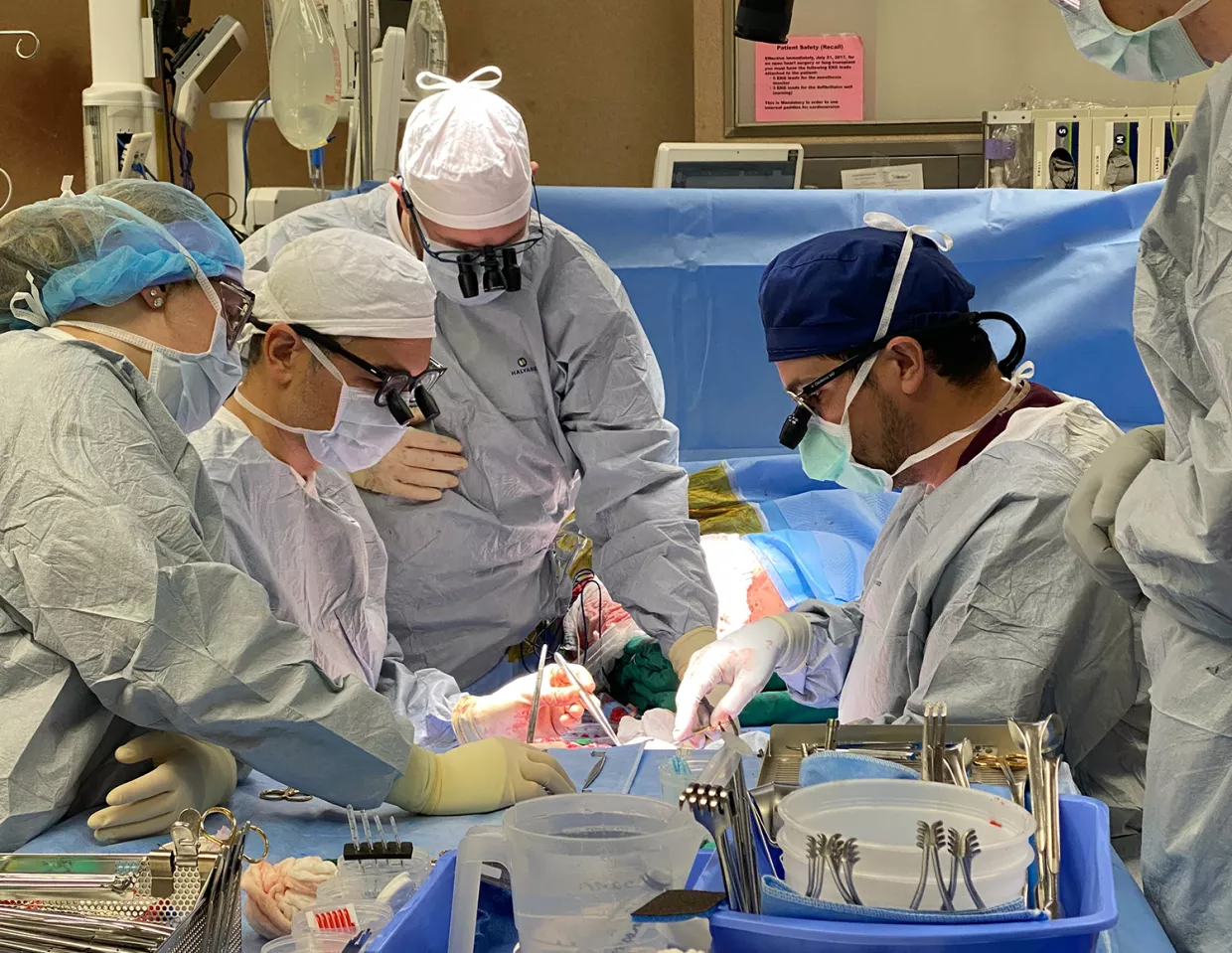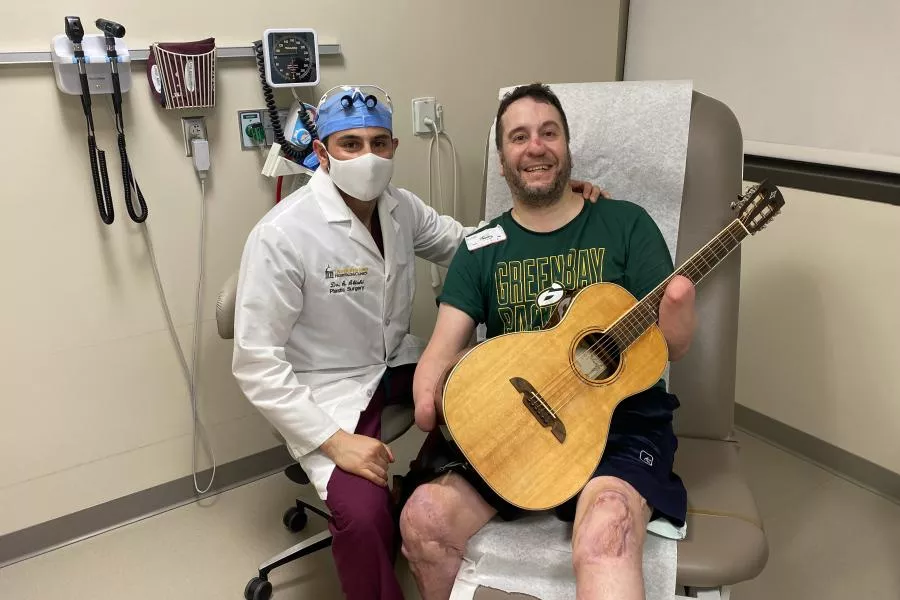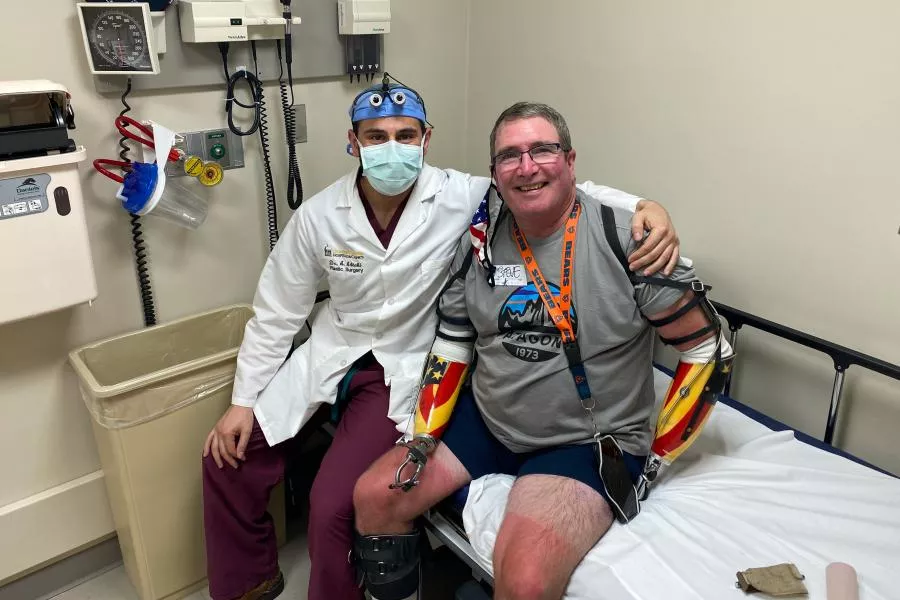Against all odds: Plastic surgery team prevails over limb-threating frostbite for two Iowa men

Though nearly 200 miles separate TJ Ricchio and Steve Lose, they are connected by similar harrowing experiences.
Ricchio, of Oelwein, Iowa, and Lose, of Menlo, Iowa, were involved in separate extreme cold-weather incidents, each resulting in hypothermia and severe frostbite to all four extremities. Both men required amputation of their hands, but thanks to the skilled expertise of the plastic and reconstructive microsurgery team at University of Iowa Hospitals & Clinics, both men retained complete use of their legs, as well as their quality of life.
“The severity of their injuries was remarkable, and the fact that TJ is alive is even more remarkable,” says Andrei Odobescu, MD, PhD, clinical assistant professor and microsurgeon who spearheaded the efforts at limb salvage for both men.
Reconstructive microsurgery refers to the use of specialized microscopes and precision instrumentation to repair blood vessels, nerves, and other intricate structures less than a few millimeters in diameter—some as thin as a strand of hair. This unique skillset is used in a multitude of meticulous procedures such as replanting severed limbs, reconstructing complex facial defects, or as with TJ and Steve, free tissue transfer –transplanting tissue from one area of the body to restore the form and function of another. Microsurgery cases are performed daily at UI Hospitals & Clinics, with the Division of Plastic and Reconstructive Surgery leading the way.
A fall in dangerous wind chills

During a polar vortex in January 2019, TJ ended his late-night work shift and stopped to get groceries. The outside temperature had plummeted to minus 20 degrees, with a wind chill of minus 60. TJ arrived home, parked his car, and began carrying groceries inside when he collapsed unexpectedly. He lay face-down on the front steps for nearly three hours before anyone noticed. “One of my friends saw my legs outside the porch, so he stopped and came up and shook me,” TJ says. “I turned my head, and he said it sounded like glass breaking because I was so frozen.”
Emergency responders revived TJ and transported him to an Oelwein hospital, where the medical team used heated blankets to rapidly raise his body temperature. Once stabilized, he was transferred to UI Hospitals & Clinics for management of his extensive frostbite injuries, including his ears, nose, hands, and lower legs.
TJ remembers waking up in Iowa City “lying in bed and watching my hands slowly die—I couldn’t stop them from turning black.”
Stuck in the snow

Near the onset of the COVID pandemic in February 2020, Steve was leaving work in Ames when a winter storm hit, bringing heavy snow, ice, and sleet to the area. Traffic on the interstate was heavy and slow-moving, blocking his usual exit, and prompting him to cross lanes toward a less familiar exit. The thick snow obscured the T-intersection at the end of the off-ramp. Steve’s vehicle slid off the roadway, rolled several times, and landed upside-down.
Three of Steve’s ribs, his collarbone, and two vertebrae at the top of his neck were broken. And even more worrisome, the temperature was minus 12 degrees, with a wind chill of minus 36, putting his life in grave danger.
“I just tried to keep myself warm,” Steve says. “I put my hands in my coat… but I was there so long, I just couldn’t keep them warm.”
Steve’s cell phone was thrown from the vehicle during the crash, so he couldn’t call for help. As the blizzard continued, his car could no longer be seen from the roadway.
“The only pain I was feeling that whole time was just my hands and feet getting so cold,” he recalls. “There was some delusion in that time, and I actually at one point thought coyotes were chewing on my hands and feet because the pain was so bad.”
The next morning—some 15 hours later—a snowplow driver saw tire tracks where Steve’s vehicle left the road. He discovered the overturned vehicle and called for help.
The microsurgery team intervenes
A multi-disciplinary team consisting of UI Health Care burn, orthopedic, and plastic surgeons coordinated the effort to stabilize both men and preserve as much functional limb length as possible – TJ underwent 16 procedures over a 26-month period, while Steve sustained 15 procedures in 14 months. Each required complete amputations of both hands and partial amputations of both feet, but due to the expertise of the reconstructive microsurgery team, TJ and Steve’s legs were saved. In TJ’s case, he also required reconstruction of his ears and nose by Mark Fisher, MD, pediatric and craniofacial surgeon in the hospital’s Division of Plastic and Reconstructive Surgery.
“With cases like [these], we typically would have looked at below-the-knee amputations, but we were really motivated to try to keep every centimeter … because we knew [they] would have had difficulty putting on prosthetics without their hands,” says Fisher, who was among the team of surgeons coordinating the efforts of limb preservation.
Sometimes the solution was found in a skin graft, harvesting a tissue-paper thin layer of skin from a healthy part of the body and transplanting it to a wounded area. But the majority of the reconstruction was completed using numerous skin and muscle flaps (approximately 10 between the two men), requiring microsurgical techniques to transfer arteries and veins that provide blood supply to the transplanted tissue.
“The challenge in any of these instances is functionality—how much function can we retain for these working individuals who are still young and still have years of mobility left in them,” says Ali Abtahi, DO MSc, who served as the chief plastic surgery resident throughout TJ and Steve’s hospitalizations. “It was really incumbent upon us as a team to put forth every possible effort to make sure TJ and Steve were able to retain some independence in their daily lives.”
“Though Steve and TJ lost their hands near the wrist, we were able to utilize a specialized microsurgical technique called Regenerative Peripheral Nerve Interfaces (RPNI) in which we wrap the severed nerve endings in small segments of free muscle,” says Odobescu. “This organizes and amplifies the nerve signals, prevents post amputation nerve pain, and improves their ability to control fine finger movements in newly-developed smart prosthetics.”
The road to recovery creates a common bond
After a four-month hospitalization, TJ’s journey continued through an extensive, months-long rehabilitation process where he worked diligently with therapists to re-learn how to walk and adapt to his new life without hands.
“It was like boot-camp,” TJ recalls of his physical therapy, “but I just kept a positive attitude throughout the whole process.”
And despite his original prognosis, TJ conquered the odds to walk again and become fully independent.
“I used to play guitar… now I teach lessons to young musicians for free. I’ve even figured out how to keep playing a couple songs.”
Months into his recovery, TJ received a phone call from UIHC’s Burn Center survivorship program which connects patients who’ve recovered from burn or frostbite injuries with recently hospitalized patients persevering through similar circumstances. The program put him in touch with Steve.
“I just wanted to make sure he was staying positive,” TJ says of his calls and texts to Steve. It was the height of the COVID pandemic and Steve was fairly isolated during his hospitalization. “He had his wife there and that really helped things…I [was] happy to help.”
TJ shared his triumphs and tribulations in overcoming his frostbite injuries—his journey through 16 reconstructive surgeries, then rehab – and how he was living a relatively normal life. TJ’s encouragement, along with his wife and daughter’s support, carried Steve through his road to recovery. “I mow my own lawn and still get projects done around the house,” says Steve, who has since made a full recovery. “My wife, Missy, and I still text and call TJ and the last time he was hospitalized for a follow-up procedure, we sent a gift to his room.”
“Today, both men are eligible for some of the pioneering work being done with prosthetics,” says Abtahi. “TJ in particular has volunteered to trial prototypes of bionic hands, some of which mimic finger sensation and allow very exact fine motor movements.”
Just a few days before Christmas 2021, Steve was being fitted for his own prosthetic hands, a device using artificial intelligence (AI) and algorithms to determine movements and dexterity.
“Our goal was to salvage their lower extremities so they could manage their lives, and we were able to do that,” Odobescu says. “Their stories and recovery are amazing. They found meaning out of their experiences, coming back stronger than most people do.”